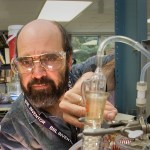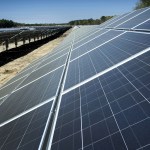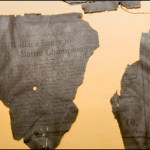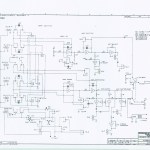Brookhaven National Laboratory
Big science is a massively collaborative endeavor. From the initial theoretical puzzles to the brilliant engineers that build on-of-a-kind machinery, experts come together to make discoveries happen. Case in point: We’re moving this 50-foot-wide physics experiment over 3,200 miles of land, sea, and river, starting on Long Island, NY and ending in Batavia, IL. Sometimes understanding the fabric of the universe requires a very technical and very long journey.
The 50-foot-wide muon ring assembled at Brookhaven Lab.
The experiment is called Muon g-2 (pronounced gee-minus-…
Magnets are neverendingly awesome, and superconductors may be the ultimate in cool—they are, after all, literally extremely cold. And not just anyone has the tools to weave superconducting magnets with compressed metallic thread. It's a more essential skill than you might think.
Ultra-cold superconducting magnets steer high-speed particles inside colliders, keeping the beams tight and guiding them smoothly through the curves of circular racetracks. But those magnets generally rely on iron, an intrinsically magnetic metal, for key structures. That works beautifully for the …
Theoretical physicist Raju Venugopalan
We sat down with Brookhaven theoretical physicist Raju Venugopalan for a conversation about “color glass condensate” and the structure of visible matter in the universe.
Q. We've heard a lot recently about a "new form of matter" possibly seen at the Large Hadron Collider (LHC) in Europe — a state of saturated gluons called “color glass condensate.” Brookhaven Lab, and you in particular, have a long history with this idea. Can you tell me a bit about that history?
A. The idea for the color glass condensate arose to help us understand heavy ion…
See the way those smooth, amorphous blobs rapidly transform into textured honeycombs? Something similar is probably happening right now inside your laptop or smartphone’s battery, providing you with portable power.
But the cherished efficiency and portability of those compact lithium-ion batteries comes with a cost: each cycle of discharge/recharge degrades the material’s essential structure and ultimate longevity - you’ve probably noticed that your older electronics just don’t hold a charge like they used to. Preventing this persistent degradation requires insight into a process that plays…
High-temperature superconductors (HTS), capable of storing and transmitting electricity with perfect efficiency, are a theoretical stumbling block. The mechanism underlying HTS behavior is a mystery, and the subject of significant contention and investigation among scientists. This puzzle, unlike headline-making unknowns such as dark energy (admittedly awesome and worth losing sleep over), could revolutionize our entire energy infrastructure. But before HTS materials can flood the electricity market, they need to work their magic closer to room temperature (high-temperature is a bit…
At first glance, this video might look like it's playing in reverse. But don't worry, these stroboscopic images were patched together in the right order.
Courtesy of Labcyte, Inc.
The video shows a technique called acoustic drop ejection (ADE) - an idea based on sending ultrasonic waves near the surface of a liquid to eject very small droplets. First demonstrated in the early 1920s, ADE is now being used by researchers to help them study extremely small biological molecules - like proteins and viruses - with x-rays at machines like Brookhaven's future National Synchrotron Light Source…
This guest post is written by Stephen R. Springston, an atmospheric chemist at Brookhaven National Laboratory. After receiving his Ph.D. in chemistry from Indiana University, he completed a postdoctoral fellowship at the University of Utah before joining Brookhaven in 1986.
Stephen Springston
After studying clouds and climate in Oklahoma during tornado season and storms atop Colorado mountaintops, a group of atmospheric scientists from Brookhaven National Laboratory will soon be helping to sample the skies over India.
We've been asked to share our expertise on conducting ground and…
Brookhaven will soon be home to the largest solar farm in the eastern United States. The Long Island Solar Farm, being constructed by BP Solar and the Long Island Power Authority on Brookhaven Lab's campus, will produce 32 megawatts of power when complete - enough to power about 4,500 homes.
The Long Island Solar Farm
Just about six months after site preparation work began in November, the farm is now more than halfway complete. To date, workers have mounted nearly 90,000 of the 164,000 solar panels that will make up the array and have installed 4,600 of the 6,800 racks that hold the…
In news that may shake the cranberry juice industry to its core, new atomic-level "snapshots" reveal how bacteria such as E. coli produce and secrete sticky appendages called pili, which help the microbes attach to and infect human bladder cells.
These crystal structures -- produced at the National Synchrotron Light Source (NSLS) at Brookhaven Lab and the European Synchrotron Radiation Facility in Grenoble, France -- unravel a complex choreography of protein-protein interactions that will aid in the design of new antibacterial drugs. Finding ways to interfere with pili formation could help…
Five years before becoming fully operational, Brookhaven's National Synchrotron Light Source II (NSLS-II) already is leading to discoveries -- of the historical kind.
Pieces of newspaper dug up at the NSLS-II construction site, which include a story about a boxing match scheduled for October 2, 1917 - Tommy Tuohey versus Ed Wallace
As earthwork takes place on the NSLS-II construction site, which housed part of the U.S. Army's Camp Upton in the World War I and II era, artifacts ranging from rusted horseshoes to nearly 100-year-old pieces of newspaper are being dug up.
One of the most…
Construction on Brookhaven's National Synchrotron Light Source II (NSLS-II) -- which will allow scientists to explore everything from fuel cell catalysts and soil samples to molecules vital for human life -- has passed the 50-percent completion mark.
The NSLS-II construction site
Work on the half-mile electron racetrack began in 2009 and is now more than a year ahead of schedule. In addition, conventional construction -- which covers everything from the roof and concrete floors to the plumbing and electricity -- is now complete on the first fifth of the ring. This milestone gives the…
How do scientists make glass stronger? Break it.
Brookhaven Lab physicists and engineers take this hands-on approach a step further. In order to strengthen the design of glass bulbs known as photomultiplier tubes, the researchers submerge the devices in 500,000 gallons of pressurized water, punch a small hole through their sides, and watch as the glass cracks, crunches, and, just milliseconds later, implodes (see videos below).
The implosion of a photomultiplier tube in a tank at BNL, as seen through combined high-speed camera images. Time scale: 6,000 frames per second.
Fifty thousand…
Earlier this month, BNL physicist Peter Takacs told you about his progress in resurrecting one of the world's first video games. And you wanted to know, "How do I do that?"
Based on feedback from that post, we've uploaded the original high-resolution schematics for Tennis for Two to the end of this story on Brookhaven's website.
An original schematic for Tennis for Two
We've also included notes from the game's inventor, William Higinbotham, as well as the deposition he gave during a legal battle over the first video game patent (held by Magnavox). So start searching for an analog…
This guest post is written by Norman Holden, a Brookhaven scientist in the National Nuclear Data Center and a member of the International Union of Pure and Applied Chemistry (IUPAC). After receiving his Ph.D. in nuclear physics from the Catholic University of America, he spent a decade at the GE Knolls Atomic Power Lab before joining Brookhaven in 1974. He is the chair of an IUPAC subgroup that is producing a periodic table meant to show high school and college students the importance of isotopes in everyday life.
Norman Holden
When the clock struck midnight on Saturday morning, we rang…
It was July 1976. The nation was busy celebrating its bicentennial, a gallon of gas cost 60 cents, and the Yankees were heading for their first postseason in 12 years, but the real action was at Brookhaven National Laboratory, scene of a life-and-death battle between Spiderman, Doctor Octopus, and the Ghost of Hammerhead.
That's right, The Amazing Spider-Man #158 was set at Brookhaven, as the reader is informed, "on Long Island's thriving North Shore: Usually these quiet buildings are merely devoted to extensive research in the field of atomic energy, but today they are an arena, a…
This one-liner from the 1967 classic "The Graduate" might have made Benjamin Braddock (Dustin Hoffman) cringe:
But 43 years later, it's obvious that Mr. McQuire was onto something. Today, it's hard to imagine life without plastic, from brushing your teeth in the morning to pouring yourself a glass of milk. We produce so much of the stuff, though, that we now face major environmental problems. Conventional plastic is made from crude oil, is not often recycled, and, when put in landfills, can release toxins that enter soil, water, and the food chain.
Researchers at Brookhaven and Dow…












